Gates of Delhi
Alai Darwaza: Qutb complex | Kashmiri Gate | West Gate: Purana Qila | Delhi Gate | Lahore Gate Red Fort | India GateThe Gates of Delhi were built in Delhi, India, under different dynastic rulers in the period that could be dated from eighth century to twentieth century. These are: i) the gates of the ancient city of Lal Kot or Qila Rai Pithora, also called the first city of Delhi (period 731-1311) in Mehrauli – Qutb Complex; ii) the gates in the second city of Siri Fort (1304); iii) the gates in the third city Tughlaqabad (1321–23), iv) the gates in the fourth city of Jahanpanah’s of (mid 14th century); v) the gates in the fifth city of Feruzabad (1354); vi) the sixth city of Dilli Sher Shahi (Shergarh) ‘s gates (1534); near Purana Qila; vii) the gates built in the seventh city Shahjahanabad of (mid 17th century); and viii) the gates in the eighth modern city New Delhi of British Raj (1931s) in Lutyens' Delhi of the British rule. In 1611, the European merchant William Finch had described Delhi as the city of seven castles (forts) and fifty two gates. More gates were built after that period also during the Mughal rule and during the British rule. But, as on date, only 13 gates exist in good shape, while all others are in ruins or have been demolished. Like all gates denote, the direction of the destination station is the starting name of the gate.
Gates in the first city
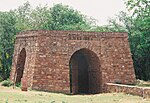 | |
| Alai Darwaza in Qutb Complex next to Qutub Minar | A refurbished Chaumukh Darwaza – Four faced Gate in the Qutub Archeological Village |
In the first city of Delhi, 13 gates were built in the 11th century citadel of Lal Kot, with the extended Qila Rai Pithora, which was ruled by the Slave Dynasty from 1192 with the establishment of the Qutb complex. These were located in the rubble built ramparts of Lal Kot (5–6 m (16–20 ft)) thickness) of which only a few remain, either in ruins or under renovation. These are the Chaumukha, Sohan, Ranjit, Fateh, Hauz Rani, Barka, Badaun and Budayuni gates. Of these, the Chaumukha, Ranjit, Sohan and Fateh darwazas have been listed by the INTACH as heritage monuments. The ruins of Hauz Rani and Barka are seen around the remains between giant gaps in the long stretches of the Lal Kot wall, surrounded by a wide moat on the outside. Archeological Survey of India (ASI) has proposed to conserve all the identified gates.
The Chaumukha Darwaza, (Chaumukha in Hindi language means four faces), is inferred as the gate way of Lal Kot since it aligns with Lal Kot walls. It is located near the Qutb Complex and has been categorized as Grade B in archaeological value. It has been conserved by the ASI. The gate’s architectural style is also traced to the Tuglaq period in view of its massive thickness. It has a “horned" outwork with paved stones in an engraved grid pattern that indicates that it was designed for defense purposes. The purpose for which it was built has not been discerned. Hence, it has also been conjectured that it could have been built by Thomas Metcalfe as one of his follies, close to his original 'Dilkusha' mansion (now seen in ruins) to enhance the elegance of his retreat.
The Ranjit gate towards the north wall of Lal Kot is in ruins. It was once considered as a grand gate through which the Turks had entered the city. Hence, it was subsequently fortified to prevent any further foreign incursions. At present, only part of the gate is seen and is yet to be listed as a heritage monument.
The Fateh Gate close to Fateh Burj has convoluted features and is about(24 m (79 ft)) in diameter. The Sohan Gate guarded by a large bastion called the Sohan Burj was stated to be the location of a Sun temple
Hauz Rani and Budayuni Gates, which were reportedly once prominent gates, are now traced in ruins. An interesting anecdote of history of the Budayuni gate, considered then as the principal gate of the city by Ibn Battuta (the chronicler of the period, mentions it as the main gate to the city), is that Allauddin Khilji had resolved to shun drinking of alcohol by emptying his wine caskets and breaking his rich Chinaware at this gate. The gate was also known for punishment meted out to the guilty. They were tortured and beheaded in public view at this gate. A strict watch was maintained at this gate to detect and prevent incursions by Mongolians.[2][9]
Alauddin Khilji had planned, as part of his ambitious architectural achievements, to build four darwazas (gates) but he could build only one during his life time, namely the Alai Darwaza (1311). This gate is seen at the southern end of the Qutb complex of the enlarged Quwwat-ul-Islam mosque, built entirely on the principles of Islamic architecture. The gate made of rectangular bands of red sandstone and white marble has inscriptions of verses from Koran and Hadis in elaborate carvings on its windows. It is a square building- (17.2 m (56 ft)) square with dome with horse shoe pointed shaped arches on three sides and with a semicircular arch on the northern side. The underside of the arches have fringed lotus bud embellishments.
Historian Fanshawe writing euphorically on the beauty of the gate has extolled:
The Alai Darwaza is not only the most beautiful structure at the Kutub, but is one of the most striking specimens of external polychromatic decoration not merely in India, but in the whole world, while the carving of interior may challenge comparison with any work of the kind. Both exterior and interior merit detailed and leisurely examination. The effect of the graceful pointed arches in the three external sides of the gate, and in the corner recesses is extremely pleasing, and the view from the exterior through the southern archway to the round-headed arch of the north side, and the court beyond, is very striking. The decoration of the north arch is curious and unique. The effect of exterior suffers, from a distant point of view, from the absence of a parapet above the walls; this was unfortunately removed by Captain Smith, as it was greatly ruined. The gate was finished five years before the emperor died, and is specially mentioned by the chronicler of his reign.
Gates in the second City
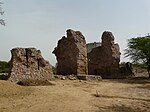 |  |
| Southern Gate of Siri Fort in ruins | Entry gate to Tugalaqabad fort and Palace |
The second medieval city of Siri Fort was built during the rule of Ala-ud-Din Khalji of the Delhi Sultanate with the major objective of protecting the city from the onslaught of the Mongols. The city, when built with an oval plan, was best described as presenting an embodiment of richness with palaces and other structures and had seven gates for entry and exit. But, at present, only the Southeastern gate exists, also in ruins (pictured). The destruction of the fort and its gates are attributed more to the local rulers of subsequent dynasties who removed the stones, bricks and other artifacts of the fort for their own buildings and palaces.
Gates in the third City
Tughlaqabad, the third city of medieval Delhi, built by Ghazi Malik well known as Ghiyath al-Din Tughluq who established the Tughlaq Dynasty in 1321 after ousting the Khiljis, was enclosed within a fort of massive proportions completed in a short span of four years. The fort has inclined walls with triple storied citadels, enormous towers, mosques and halls. The city when built is stated to have had 52 gates but only 13 remain today, mostly in ruins. Of the remaining gates, the main entry gate to the fort was built in typical Pathan style, which is described as made of red sand stone with sloping face and jambs which merge well with the towers of the fort. But the fort was abandoned soon after Ghiyasuddin’s death for two reasons namely, water shortage and the fool hardy decision of his successor Sultan, the Muhammad bin Tughlaq who forcibly shifted his capital to the new city of Daulatabad in the Deccan and retuned back to found the fourth city of Jahanpanah.
Gates in the fourth City
Muhammad bin Tughluq, first built Adilabad, then Nai-ka-Kot, towards the south of Tughlaqabad. These were two small fortresses. But he soon abandoned them. He built a new city by enclosing the areas lying between the cities of Siri, Tughlaqabad and Lal Kot. The city was named as Jahanpanah, asylum of the world, in 1334. The city had 13 gates. The ruins of gigantic ramparts of his two fortresses and some portions of the Jahanpanah walls have survived the ravages of time but are seen now only in total ruins. The watchtower Bijai Mandal still stands in ruins in the city of Jahanpanah. But no fort gates are traced.
Gates in the fifth City
Firuz Shah Tughlaq built a new capital city on the banks of the Yamuna River in 1351 and called it Firuzabad. The architecture of the fort was fairly simple and straightforward. The city had three palaces and a citadel known as Feroz Shah Kotla. The king's as well as his wife's quarters were situated along the riverfront. The structures within the enclosure walls of the fort were barracks, armories, servant's rooms, halls for audience, an imposing mosque as well as public and private baths and a stepped well or baoli. An Ashokan pillar brought from Topara, Ambala was mounted on top of a pyramidal three-tiered construction. No gates of this period exist.
Gates in the sixth city
 |  |
| South Gate Purana Qila | View of Talaqi Darwaza of Purana Qila |
Three main gates on the north, south and west are part of the fortifications of the Purana Qila, the sixth city of Delhi, built by Sher Shah Suri (1538–45). Sher Shah Suri raised his citadel after demolishing Dinpanah, the city built by Humayun. The fortifications of the Qila extended to a boundary of (2 km (1.2 mi)) on an irregularly oblong plan. Bastions adorned the corners and the western wall. Of the existing three gates, the west gate forms the entrance to the Qila and is called the Bara Darwaza (big gate). All three gates are double–storied structures built with red sandstone and have chhatris. The enclosure wall inside has cells in two–bay depth. The northern gate, built in 1543–44, is called the Talaqi-Darwaza for reasons unknown. On this gate, in the front, carved marble leogryphs in combat with a man are seen above the oriel windows. Built in random rubble masonry with dressed stone facing, the gate has a tall arch enclosed by two smaller arched openings. Two bastions adorn the gate with high ceiling rooms. On the second floor of the gate, there are two openings. Exterior surface of the gate had coloured tiles and the inner rooms were covered with incised plaster work. The Purana Qila was stated to have been left unfinished by Suri, which was later completed by Humayun. The southern gate is called the Humayun Darwaza; the reasons attributed for the name are that either Humayun built it or the gate overlooked Humayun’s tomb. An inscription in ink on the gate refers to Sher Shah with the date as 950 A.H. (1543–44).
- Sher Shah Gate
Sher Shah gate located to the south of Khairu’l-Manazil-Masjid is said to be an entrance to the large city of Delhi that Sher Shah built in front of his fortress of Purana Qila. The gate, mostly built with red sandstone but with use of local grey quartzite in its upper storey, is thus called the Lal Darwaza (red gate). Arcades were built from this gate into the city, which were provided with series of dwellings with frontage of a verandah, which may have been used for commercial establishments. Kabuli or Khuni–Darwaza (explained in the following section) is another gate on the fringes of Sher Shah’s city. ASI has undertaken extensive conservation works of the gate and its surroundings at a cost of Rs 75 lakhs (US$150,000).
Gates in the seventh city
Shahjahanabad, the seventh city of Delhi, was built by Shah Jahan in 1649 like a fortress encircled by strong and high red–brick walls with 14 entry gates to the city, in addition to 16 wicket gates called windows (khirkis in Urdu language). A number of bastions built of stone were added by the British, in addition to repairing the earlier fort, to make the fort more secure. The gates were designed and built for the people to have access and the royal procession to enter or exit, when going out in diverse directions. Out of the 14 gates, five gates have survived, namely, the Kashmiri Gate on the north, the Ajmeri Gate on the south-west, the Delhi Gate on the south-east, Turkman Gate on the south and the Nigambodh Gate on the north-east, all of which express vividly the splendor of the city. All the gates are located within a radius of (5–6 km (3.1–3.7 mi)) in the present day Old Delhi. The Lahori gate on the Northeast, in the old city, was demolished (some remnant walls are seen at the crossing as may be seen in picture) and the area converted into the present day Lahori Bazar. The gates have a square plan with high arched openings, except for low height of the Nigambodh gate, and two openings — one for entry and another for exit — of the Kashmiri gate. [9] The names of all the gates, which existed during Shahajahan’s time are the Dilli Darwaza (also known as Delhi Gate), Kabuli Darwaza, Raj Ghat Darwaza, Khizri Darwaza, Nigambodh Darwaza, Kela ke Ghat ka Darwaza, Lal Darwaza, Kashmiri Darwaza, Badar Darwaza, Patthar Khati Darwaza, Lahori Darwaza, Ajmeri Darwaza and Turkuman Darwaza. The names of the wicket gates or windows (now none exist) through which people entered and exited from the old fort city were: 1) Zeenatul Masajid Khirkee; 2) Nawab Ahmad Bakhsh ki Khirkee; 3) Nawab Ghaziuddin ki Khirkee; 4) Musamman Burj ki Khirkee; 5) Muslim Garh ki Khirkee; 6) Naseer Ganj ki Khirkee; 7) Nai Khirkee; 8) Shah Ganj Khirkee; 9) Ajmeri Darwaza ki Khirkee; 10) Sayyad Bhole ki Khirkee; 11) Buland Bagh ki Khirkee; 12) Farash Khana ki Khirkee; 13) Ameer Khan ki Khirkee; 14) Khalil Khan ki Khirkee; 15) Bahadur Ali Khan ki Khirkee; and 16) Nigambodh ki Khirkee. However, the Red Fort also has two gates namely, the Delhi gate and the Lahore gate, which are well maintained.
- Kashmiri gate
 |  |
| Kashmiri Gate preserved as a Heritage monument | Mortar damage to Kashmiri Gate, Delhi, 1858 |
Kashmiri Gate is one of the original fourteen gates built into the wall to the north of the city. It was built by the British in 1835 by Major Robert Smith. Local people also call it as Truckman gate. It has a square plan. There are two openings of the gate – one for entry and another for exit (pictured). During 1835, the British enlarged and straightened it into a two way gate as defensive measure against enemy attacks. In the present city setting, the gate is close to the Inter State Bus Terminals. It is now preserved as monument on the road to the Old Secretariat and the Delhi University. It was named as Kashmiri Gate since it was used by the Emperors to go through this gate on their visits to Kashmir and North India. It was also the historic venue of the intense fighting which took place in 1857, between the British army and the Indian freedom fighters. The fortifications of this gate were used to fire cannons at the British army encamped at Ludlow Castle. The freedom fighters gathered at a place close to the St. James Church to discuss war strategy. British troops fought fiercely at this gate and re– captured the city from mutinous Indian soldiers. During the war, the gate was badly damaged by the British to get control over Delhi. Subsequently, area surrounding the Kashmiri Gate became the commercial hub of Delhi, when the Civil Lines were developed by the British.
- Delhi gate
 |  |
| Delhi Gate that links Daryaganj of Old Delhi with New Delhi | View of Turkman gate |
Delhi gate on the south east, so named because of its large size, was built by Emperor Shah Jahan in 1638 as part of the rubble–built high fort walls that encircled the Shahajahanabad. Shahajahanabad was the seventh city of Delhi on its southeast stretch. It was built in a polygonal shape and lead to other earlier cities of Delhi. It was built at the start of the Daryaganj. The road was also called the Thandi sadak (the cool street) as it was a tree lined avenue. The gate, square in plan, was built in sandstone and is an impressive and large structure. Near the gate entry, two stone carvings of elephants were erected. The Emperor used this gate to go to the Jama Masjid for prayer. The road from this gate passing through Daryaganj lead to the Kashmiri gate. A part of the fort wall to the east has been demolished to build the Old Delhi Railway Station while the wall to the west exists. It is now a heritage gate maintained by the ASI and roads on either side leads Daryaganj, goes to the Kashmiri gate with Jama masjid on the left and the Red Fort to its right.
- Ajmeri Gate
Ajmeri Gate, built in 1644, to the south–west of Shahjahanabad with a square plan, has high arched openings. The Sepoy Mutiny or the first war of Indian independence in 1857 was fought at this venue also. The road, through this gate, leads to the city of Ajmer in Rajasthan, and hence its name. A lovely park surrounds the gate. The madrasa (Islamic school of learning) of Nawab Ghaziuddin Bahadur and Anglo Arabic Senior Secondary School were located in the vicinity. At present, the old walls of the fort have been demolished and replaced by commercial buildings and residential complexes, but the gate on the west exists.
- Turkman Gate
 | 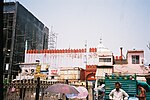 |
| View of Ajmeri Gate | Remnant of old Lahori Gate at Lahori Bazar crossing |
Turkman Gate, located to the southern edge of Shahajahanabad, is named after the Sufi Saint Hazrat Shah Turkman Bayabani. His tomb dated to 1240, before building of Shahjahanabad, is located to the east of the gate. It is approached from the Jawahar Lal Nehru Road, the old Circular Road, in the vicinity of the Ramlila Grounds. It has a square plan with high arched openings. The tomb of Razia Sultan and Kali Masjid or Kalan Masjid are located in close proximity of the gate.
- Red Fort gates
Red Fort has two well maintained gates namely the Lahori gate and the Delhi gate The Lahori gate of the Old Delhi city (now only a bazaar square with small remnants at one end) links with the Lahore gate of the Red Fort enclosing the Lahori bazaar and the Chandni Chowk in a length of (1.6 km (0.99 mi)). The Lahore gate is the main gate to the Red fort and is named so since it is oriented towards Lahore in Pakistan. Delhi gate was the main entrance linking Red fort with the city but entry is now restricted since it provided access to a large army camp inside the Fort (since vacated). It is used by the public. It is said that during Aurangzeb's reign the beauty of both the gates was spoiled by adding bastions: "The vista like a veil drawn across the face of a beautiful woman". In the 1980s, the area became a security zone due to its use for Indian Independence Day celebrations on 15th August for the flag hoisting and delivering an address to the Nation by the Prime Minister of India from the ramparts of the Red Fort. This necessitated blocking of the gate's tower windows as a security measure to prevent any kind of stealthy sniper attacks. At that time, a Lift was also added to the gate for use by the Prime Minister.
- Nigambodh Gate
It was built on the north eastern side of the Shahajahanabad. It is located on the Ring Road near the Yamuna Bazaar. It derives its name Nigambodh Ghat from the burial ground here. The etymology of Nigambodh is derived from Sanskrit words ‘Nigam’ which means the “Ved” and ‘bodh’ means “knowledge”, meaning realization of knowledge. According to a folk legend, Lord Brahma (the creator) took a bath in the Yamuna River at this ghat to recover his lost memory and by this act Brahma not only got back his memory but also remembered the place he had kept his sacred books. In the past, the gate was closer to the ghat and nearer to the Salimgarh Fort.
- Khooni Darwaza
 | 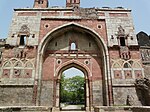 |
| View of Khuni Darwaza | Sher Shah gate or Lal Darwaza |
Khooni Darwaza, literally translated means “Bloody Gate”, a “morbid sounding name”, though not within the walls of the Shahajahan's fort. Its historic significance is linked with the 1857 War of Indian Independence. Located on the Mathura road opposite to the Ferozshah Kotla near Maulana Azad Medical College, it is an impressive double–storied structure. Its construction is credited to Sher Shah Suri's reign (though the fort walls of the Suri period have not been seen to extend to this gate). It was built largely with grey stone but red stones were also used in the frames of its windows. According to the recorded history of the 1857 war (also called the Mutiny of 1857), the sons of Bahadur Shah, the last Mughal Emperor (who had taken shelter in Humayun's tomb) were arrested by the British officer named Captain William Hudson and while taking them to the Red fort shot them dead and displayed their body on this gate for public viewing. He justified his action by claiming that a crowd which had assembled to see their arrested princes was restive and fearing an attack from the crowd he shot the two princes. Their dead bodies were also displayed at the Chandni Chowk. The gate is also the location where Dara Shikoh's severed head was displayed. In the battle of succession for the throne of Delhi, Aurangzeb murdered his brother Dara Shikoh and hung his severed head at this gate. During the riots in 1947, after the Partition of India, many refugees were murdered here as they were trying to reach Purana Qila for safety.
- Bahadur Shahi Gate
 |  |
| Bahadurshah gate linking Red Fort and Salimgarh Fort through the arched bridge | Entry Gate to Salimgarh Fort (renamed as Swatantrata Senani Smarak |
Salimgarh Fort, which is now part of Red fort complex, was constructed on an island of the Yamuna River in 1546. But a gate called the Bahadur Shahi Gate for entry into the Fort from the northern side was constructed only in 1854–55 AD by Bahadur Shah Zafar, the last Mogul ruler of India. The gate was built in brick masonry with moderate use of red sandstone. The fort was used during the Uprising in 1857 and also as prison, which housed Zebunnisa, daughter of Aurangzeb; the British imprisoned the freedom fighters of INA. The layout of the Red Fort was organized to retain and integrate this site with the Salimgarh Fort through the Bahadur Shah Gate.
Gates in the eighth City
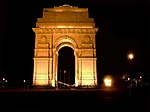 |  |
| India Gate (east face at night) commemorates Indian soldiers who lost their lives in World War I and the Afghan Wars | Entrance steel gates to Rashtrapati Bhavan with a Victory pillar called Jaipur Column in the background |
Delhi became the capital of British India after the seat of power was shifted from Calcutta in 1911. With this shift, the new city of New Delhi was established and the sixth city of Shahajahanabad to its north became the Old Delhi.Based on the designs of Edwin Lutyens, New Delhi was built over a period of 20 years. One of the important land marks built during this period was the India Gate.[5]Built in 1921, it is officially known as All India War Memorial (an arch) to the Indian soldiers killed in the World War I, the Northwest frontier operations of the same time and the 1919 Afghan fiasco. The Gate has an impressive stone arch of (42 m (140 ft)) height; the names of over 90,000 soldiers are engraved on it. The base of the gate is built in red Bharatpur stone and displays a shallow domed bowl. The past tradition was to fill this bowl with oil and light it as a lamp on anniversaries but is no more practiced, instead an eternal flame burns below the arch. The eternal flame was added in 1970s in the arch of the Gate to honour the Unknown Soldier. The location is flanked by two uniformed soldiers. The place takes a carnival atmosphere in the evenings when it is well lighted and visitors flock to the gate. Also seen behind the India Gate is an impressive Chhatri, which displayed the statue of King George V till 1968. This statue has been shifted to the Coronation Park, Delhi, which was the site of the declaration of the new capital of Delhi. The Chhatri is now devoid of any statue since there is a protracted discussion on which National leader's statue should be installed there. There is an impressive set of a large central steel gates flanked by asymmetrically designed smaller gates that provides entry into the Rashtrapati Bhavan (President's palace). A commemorative column called the 'Jaipur Column' with a "distinctly peculiar crown: a glass star springing out of bronze lotus blossom", is located midway between the entry gates and the Rashtrapati Bhavan.
Gallery
| Ancient view of Alai Darwaza | South gate entry to Tughlaqbad fort | South Gate Purana Qila | |
| North gate Purana Qila | Red Fort entry gate | ||
| Water Gate of Red Fort | Delhi Gate of Red Fort |



















0 Comments:
Post a Comment